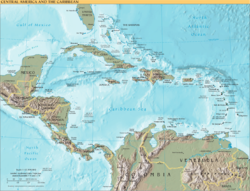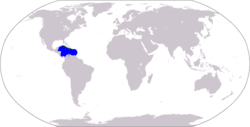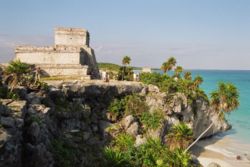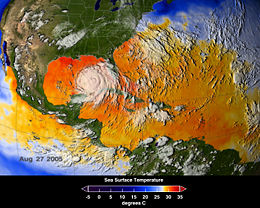Caribbean Sea
2008/9 Schools Wikipedia Selection. Related subjects: Geography
The Caribbean Sea (pronounced /kəˈrɪbiən/ or /ˌkærɨˈbiːən/) is a tropical sea in the Western Hemisphere, part of the Atlantic Ocean, southeast of the Gulf of Mexico. A mediterranean sea, it covers most of the Caribbean Plate and is bounded on the south by South America, on the west and south by Mexico and Central America, and on the north and east by the Antilles: the Greater Antilles islands of Cuba, Hispaniola, Jamaica, and Puerto Rico lie to the north, and a plethora of Lesser Antilles bound the sea on the east. The entire area of the Caribbean Sea, the numerous islands of the West Indies, and adjacent coasts, are collectively known as the Caribbean.
The Caribbean Sea is one of the largest salt water seas and has an area of about 2,754,000 km² (1,063,000 square miles). The sea's deepest point is the Cayman Trough, between Cuba and Jamaica, at 7,686 m (25,220 ft) below sea level. The Caribbean coastline has many gulfs and bays: the Gulf of Gonâve, Gulf of Venezuela, Gulf of Darien, Golfo de los Mosquitos and Gulf of Honduras.
History
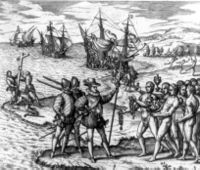
The name "Caribbean" is derived from the Caribs, one of the dominant American Indian groups in the region at the time of European contact during the late 15th century. After the discovery of the West Indies by Christopher Columbus in 1492, the Spanish term Antillas was commonly assigned to the lands; stemming from this, "Sea of the Antilles" is a common alternative name for the Caribbean Sea in various European languages. During the first century of development, the Spanish dominance was undisputed.
The Caribbean Sea was an unknown body of water to the populations of Eurasia until 1492 when Christopher Columbus first sailed into Caribbean waters while trying to find a route to India. At that time the Western Hemisphere in general was unknown to Europeans. Following the discovery of the islands by Columbus, the area was quickly colonized by several Western Civilizations. Following the colonization of the Caribbean islands, the Sea became a busy area for European-based marine trading and transport, and this commerce eventually attracted piracy.
Today the area is home to 22 island territories and borders 12 continental countries. Because of an abundance of sunshine, year-round tropical temperatures moderated by the almost constant trade winds, and the great variety of scenic destinations to visit, during the second half of the 20th century on into the 21st, the Caribbean Sea became a popular place for tourism, and this trend has favored the increasing development of the cruise industry in the area (see Cruising and Cruise ship).
Geology
The Caribbean Sea is an oceanic sea largely situated on the Caribbean Plate. Estimates of the sea's age range from 20,000 years to 570 million years. The Caribbean sea floor is divided into five basins separated from each other by underwater ridges and mountain ranges. Atlantic Ocean enters the Caribbean through the Anegada Passage lying between the Lesser Antilles and Virgin Islands and the Windward Passage located between Cuba and Haiti. The deepest points of the sea lie in Cayman Trough with depths reaching approximately 7,686 m (25,220 ft). Despite this, the Caribbean Sea is considered a relatively shallow sea in comparison to other bodies of water.
The Caribbean sea floor is also home to two oceanic trenches: the Hispaniola Trench and Puerto Rico Trench, which put the area at a higher risk of earthquakes. Underwater earthquakes pose a threat of generating tsunamis which could have a devastating effect on the Caribbean islands. Scientific data reveals that over the last 500 years the area has seen a dozen earthquakes above 7.5 magnitude.
Ecology
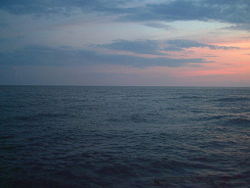
The Caribbean is home to about 29% of the world's coral reefs covering about 20,000 square miles (50,000 km²), most of which are located off the Caribbean Islands and the Central American coast. Currently, unusually warm Caribbean waters are endangering the Caribbean coral reefs. Coral Reefs support some of the most diverse habitats in the world, but are fragile ecosystems. When tropical waters exceed 85 °F (29 °C) for an extended period of time, microscopic plants called zooxanthellae die off. These plant provide food for the coral and give them their colour. The resultant bleaching of the coral reefs kills them, and ruins the ecosystem. Up to 42% of the coral colonies have gone completely white, while 95% have undergone at least some bleaching. The habitats supported by the reefs are critical to such tourist activities such as fishing and diving, and provide an annual economic value to Caribbean nations of $3.1-$4.6 billion. Continued destruction of the reefs could severely damage the region's economy. A Protocol of the Convention for the Protection and Development of the Marine Environment of the Wider Caribbean Region came in effect in 1986 to protect the various endangered marine life of the Caribbean through forbidding human activities that would advance the continued destruction of such marine life in various areas. Currently this protocol has been ratified by 15 countries. Also several charitable organizations have been formed to preserve the Caribbean marine life, such as Caribbean Conservation Corporation which seeks to study and protect sea turtles while educating others about them.
Weather
The Caribbean weather is influenced by the Gulf Stream and Humboldt Current ocean currents. The tropical location of the sea helps the water to maintain a warm temperature ranging from the low of 70 to mid-80 degrees Fahrenheit by the season.
The Caribbean is a focal area for many hurricanes within the Western Hemisphere. A series of low pressure systems develop off the West coast of Africa and make their way across the Atlantic Ocean. While most of these systems do not become tropical storms, some do. The tropical storms can develop into Atlantic hurricanes, often in the low pressure areas of the eastern Caribbean. The Caribbean hurricane season as a whole lasts from June to December, with the majority of hurricanes occurring during August and September. On average around 9 tropical storms form each year, with 5 reaching hurricane strength. According to the National Hurricane Centre 385 hurricanes occurred in the Caribbean between 1494 and 1900.
Every year hurricanes represent a potential threat to the islands of the Caribbean, due to the extremely destructive nature of these powerful weather systems. Coral reefs can easily be damaged by violent wave action, and can be destroyed when a hurricane dumps sand or mud onto the a reef. When this happens, the coral organisms are smothered and the reef dies and ultimately breaks apart.
Economy and human activity
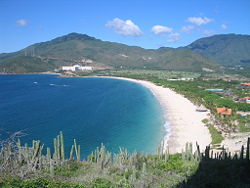
The Caribbean region has seen a significant increase in human activity since the colonization period. The sea is one of the largest oil production areas in the world, producing approximately 170 million tons per year. The area also generates a large fishing industry for the surrounding countries, accounting for half a million metric tons of fish a year.
Human activity in the area also accounts for a significant amount of pollution, Pan American Health Organization estimating in 1993 that only about 10% of the sewage from the Central American and Caribbean Island countries is properly treated before being released into the Sea.
The Caribbean region supports a large tourist industry. The Caribbean Tourism Organization calculates that about 12 million people a year visit the area, including (in 1991–1992) about 8 million Cruise Ship tourists.
Popular culture
The Caribbean is the setting for countless literary efforts often related to piracy and swashbuckling. One memorable work of pulp fiction has in its title a geographic feature unique in its way to the islands: Fear Cay, the eleventh Doc Savage adventure by Lester Dent. Many James Bond adventures were set there. It is also well known as the location of the Pirates of the Caribbean films, featuring Port Royal
